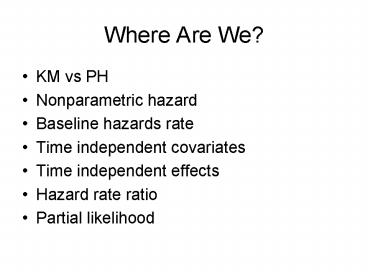Where Are We
1 / 29
Title: Where Are We
1
Where Are We?
- KM vs PH
- Nonparametric hazard
- Baseline hazards rate
- Time independent covariates
- Time independent effects
- Hazard rate ratio
- Partial likelihood
2
What is your Quest?(for today)
- Tied data
- Convergence
- Interactions (back to problem 2, KK p120-1)
- Example of PH fertility longevity
3
Tied Event Times
- The exact method
- assumes that ties are due to the lack of
precision in measuring survival time - computes all possible orderings of the tied event
times - is very CPU intensive with large data sets that
contain many ties.
4
Tied Event Times
- The discrete method
- assumes events occurred at exactly the same time
- computes probabilities that the events occurred
to a set of subjects with tied event times - is very CPU intensive, but not as much as the
exact method.
5
Tied Event Times
- The Breslow method
- is an approximation of the exact method
- works well when the number of ties are relatively
few - yields coefficients biased towards 0 when the
number of ties is large - is the default in PROC PHREG
- uses less CPU time for large data sets compared
to the exact and discrete methods.
6
Tied Event Times
- The Efron method
- is also an approximation to the exact method
- yields coefficients that are closer to the exact
method compared to coefficients obtained from the
Breslow method - also yields coefficients biased towards 0 when
the number of ties is large - uses approximately the same CPU time as the
Breslow method.
7
Convergence Problems
Number Censored
Number of Events
Yes
0(0)
0(2)
0(2)
0(6)
Treatment
No
2(1)
1(0)
1(1)
2(2)
1
2
3
4
Time
8
Convergence Problems
Variable
SE
Treatment
18.58
3751
Test
Chi-Square
P-value
Likelihood Ratio
10.38
0.0013
Score
8.29
0.0041
Wald
0.00
0.9960
9
SAS and PH with Interactions
- Interactions
- Why bother?
- How to interpret these
- Mutlicollinearity
- Path to enlightenment To be centered
- SAS particulars
- Proc Standard
- Merging data sets
- Collinearity diagnostics
10
Fertility and LongevityAre Kids Good For You?
11
Priscilla and Lee Arrington, 1906 Both age
48 Priscilla bore 9 children (8 shown), the last
at age 43
12
Lee and Priscilla Arrington, 1948 or 1949, 90
years old
13
Jeanne Louise Calment Died 1997 at age
122 Longest-lived person with authenticated
records Bore one child
14
The oldest man in the United States last year
died in 2002 from heart failure at the age of
113. John McMorran, who was born June 19, 1889,
in a log cabin in Michigan, considered coffee his
elixir and quit cigars at age 97. He was the
fourth-oldest person in the world.
15
Why Should Children Affect Your Life Span After
50?
16
Parental Health and Longevity Benefits of
Children to Men and Women
Children as sources of social support Children in
times of need (widowhood, illness) Children
enhance social integration Providing a sense of
purpose Children reduce parental
risk-taking Reduced risk of some cancers (breast,
ovarian) With late fertility, enrich life in
middle and older ages
17
Parental Health and Longevity Costs of Children
to Men and Women
- Greater fertility (children and grandchildren)
may limit accumulation of wealth - Intergenerational resource flows may be more
downward than upward - Maternal mortality
- Late fertility - being an old parent with young
children prospect of being widowed with young
children
18
Late Natural Reproduction in Females
- Slow aging ovaries may mean slow overall rates of
aging - Late Natural Menopause vs. Late Fertility
- Positive association between female longevity and
late fertility - Perls et al, 1997 - 76 centenarians, 54 controls
in Boston - Positive association between female longevity and
late natural menopause - Snowdon et al, 1989 - Seventh Day Adventists
- Cooper and Sandler, 1998 - NHANES I
19
Flies, Aristocracy, and Nuns
20
Utah Population Database (UPDB)
21
Survival Past Age 60 By Sex, Utah 2000
Female Life expectancy 25.5
Male Life expectancy 21.8
3.7 Year Difference in Life Span
AGE
22
Survival Past Age 60 By Sex,Among Married
Couples, Utah 1890
Female Life expectancy 21.2
Male Life expectancy 17.7
3.5 Year Difference in Life Span
60
70
80
90
100
AGE
23
Is More BetterEffects of Parity
24
3 Year Difference in Life Span Between Parity 1-3
and Parity 15
Females Parity 1-3
Females Parity 15
25
Effect of Parity on Exceptional Longevity
Significantly different longevity from average
fertility (7-11 children)
Odds Ratio
Died After 93 vs before 85
Died After 91 vs before 83
26
The Last OneAge at Last Birth
27
(No Transcript)
28
Effect of Wifes Age at Last Birth on
Exceptional Longevity
Odds Ratio
Died After 93 vs before 85
Died After 91 vs before 83
29
(No Transcript)































